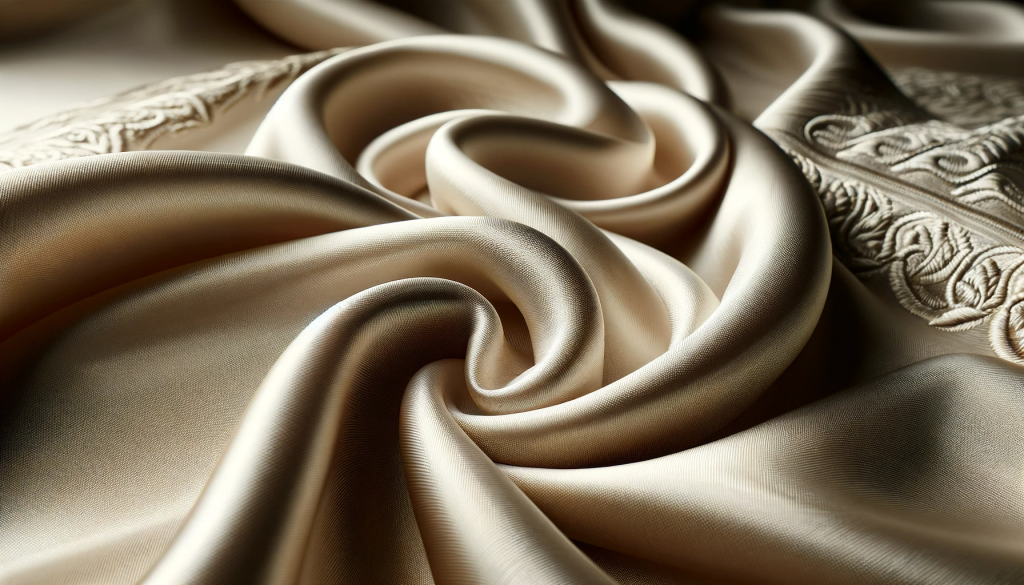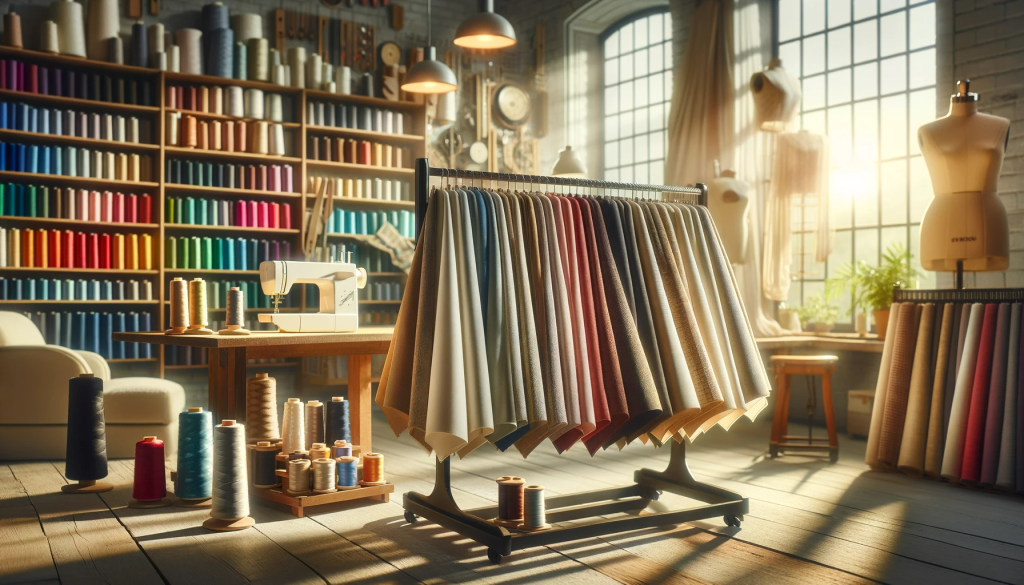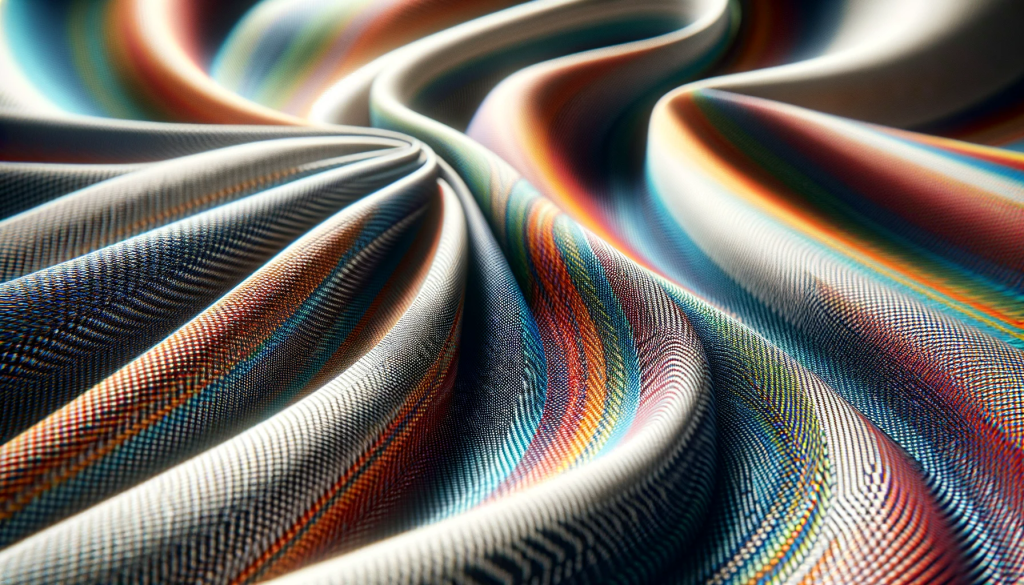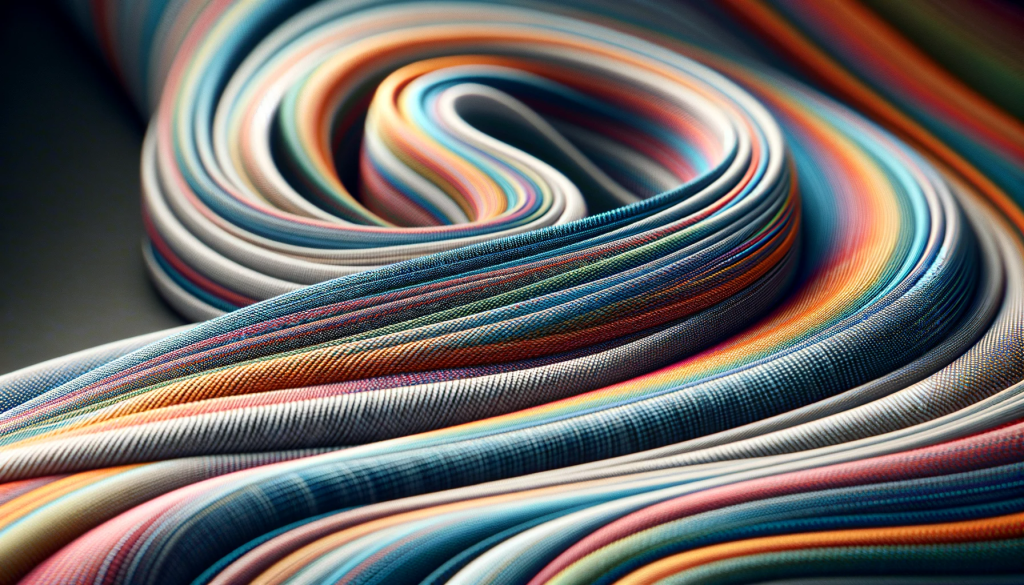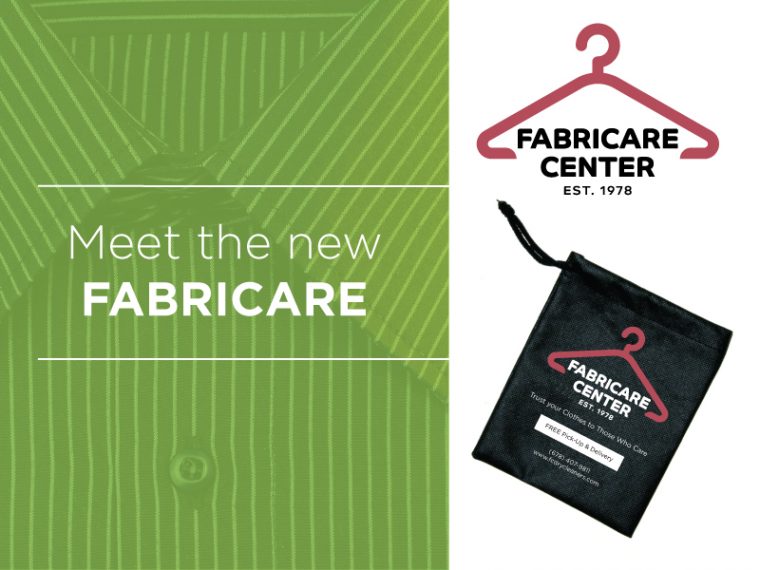
What Is Rayon Fabric: About, Cleaning, Care Tips & More
Fabricare Center Blog , Garment Cleaning
Have you ever pulled your favorite shirt from the dryer only to find it’s shrunk? Rayon is a popular fabric known for its silk-like feel and beautiful drape. This article will guide you through understanding what rayon fabric is, how to effectively clean and care for it, ensuring your garments maintain their allure.
Keep reading to become a rayon-care pro!
Key Takeaways
- Rayon is a semi-synthetic fabric made from cellulose fibers with a silk-like feel, available in various types such as viscose, modal, lyocell, and bamboo rayon.
- Proper care of rayon includes washing in cold water on a gentle cycle or by hand without wringing out the fabric; drying flat away from direct heat; and ironing at low temperatures using a pressing cloth.
- Environmental concerns exist surrounding the production of rayon due to the use of harmful chemicals, but sustainability can be improved through responsible manufacturing practices and consumer choices.
- Rayon is less durable than some other fabrics and may shrink or lose color if not cared for correctly; it requires attention to maintain its appearance over time.
- Alternatives to traditional rayon include organic cotton, hemp, linen, Tencel™️ (lyocell), recycled polyester, and responsibly sourced wool—each offering varying degrees of sustainability benefits.
What is Rayon Fabric?
Rayon fabric is a versatile textile with a silk-like feel, known for its affordability and adaptability in fashion and home decor. It’s a semi-synthetic material crafted from regenerated cellulose, striking a balance between natural and synthetic fibers to offer comfort and functionality in various garments.
Definition of Rayon
Rayon is a soft, versatile fabric often used in clothing and home textiles. It’s made from regenerated cellulose fibers, which come from wood pulp or cotton linters, giving it a smooth feel similar to natural fabrics like silk or cotton.
Despite its plant-based origins, rayon is considered a synthetic fabric because of the chemical process used in its creation.
Manufacturers love rayon for its ability to hold vibrant colors and drape gracefully, making it a popular choice for everything from blouses and dresses to bedding and curtains. The textile industry values this material for its luxurious look without the high cost associated with some organic fibers.
Rayon breathes like cotton and has a good absorbency level, which contributes to wearing comfort in different climates.
How Rayon is Made
Understanding rayon begins with recognizing its origins, which trace back to natural sources. Manufacturers create this versatile fabric by chemically transforming cellulose, usually sourced from wood pulp from trees such as beech, pine, and eucalyptus.
The process starts with harvesting the desired wood and extracting pure cellulose through a series of steps that involve chipping the wood and dissolving it in chemicals. This forms a viscous solution known in the textile industry as ‘viscose’, which is then spun into fibers.
The transformation continues when these viscous strands pass through a spinneret; picture it like a showerhead turning liquid into fine threads. Once they emerge, the strands solidify after exposure to air and are set using sulfuric acid, resulting in semi-synthetic fibers ready for weaving or knitting.
Next comes washing and purifying these filaments to enhance comfort against the skin. After thorough cleaning and drying processes, we get soft yet strong threads that can mimic silk or cotton: welcome to rayon – diverse not just in application but creation too!
Different Types of Rayon Fabrics
Exploring the variety within rayon fabrics reveals a world of textiles each with unique properties and uses. Let’s dive into the different types that you might encounter.
- Viscose Rayon: Known as the most common type, viscose mimics the feel of silk with a soft, smooth texture. It’s breathable and highly absorbent, making it a favorite for summer wear.
- Modal Rayon: This form is known for its increased strength when wet. Modal resists shrinkage and fading, so it keeps its shape and color well, perfect for clothing that undergoes regular washing.
- Lyocell: Also sold under the brand name Tencel, lyocell stands out for its eco-friendly production process. It boasts high durability and moisture-wicking features which make it ideal for activewear.
- Cuprammonium Rayon: Often referred to as cupro, this type is finer and lighter than other rayons. Because of its silky touch, cupro is commonly used in luxurious lingerie and lining of high-end garments.
- Bamboo Rayon: Produced from bamboo pulp, this variant combines sustainability with softness. It’s naturally antibacterial and hypoallergenic; therefore, it suits sensitive skin or allergy-prone individuals.
How is Rayon Fabric Made?
Delving into the creation of rayon fabric reveals a fascinating process that transforms natural cellulose into luxurious, versatile textiles. By understanding this journey from raw material to finished product, we shed light on the complexity and craftsmanship behind one of fashion’s favorite fibers.
Process and Materials Used
Creating rayon fabric starts with cellulose, usually sourced from wood pulp or cotton. Manufacturers dissolve the cellulose in chemicals like caustic soda and carbon disulfide, turning it into a thick solution called viscose.
This viscous solution is then forced through tiny holes in a spinneret, solidifying into strands as it hits the air. These filaments are drawn out to create threads, which are spun together to form yarns.
The resulting yarn is woven or knitted to produce soft, versatile rayon fabrics used across the textile industry. Makers dye these textiles in vibrant colors due to their high absorbency rate compared to other synthetic fabrics.
Rayon stands out for its silk-like feel while being significantly cheaper than most natural fibers. However, special care is needed when washing rayon fabric because it can shrink if not handled correctly—machine washing should be gentle and fabric softener usage minimal.
Environmental Concerns
Making rayon fabric raises several environmental concerns. The chemicals used to transform plant pulp into soft threads can harm ecosystems if not managed properly. Factories may release toxic substances into the air and water, threatening wildlife and human health.
This waste is a significant issue in countries with lax regulations.
Consumers are becoming more aware of these impacts, pushing for ecofriendly textiles and sustainable fashion choices. Manufacturers are now exploring greener alternatives to traditional methods, reducing pollution and conserving resources where possible.
By choosing responsibly-made rayon products, we support practices that prioritize our planet’s well-being over profit.
Comparison to Other Fabrics
When comparing rayon to other fabrics, it’s important to consider various factors such as breathability, production costs, environmental impact, and care requirements. Here is a summary of how rayon stacks up against other common textiles:
| Fabric | Breathability | Production Cost | Environmental Impact | Care Requirements |
| Rayon | High | Medium | Variable | Gentle wash, low heat dry |
| Cotton | High | Low to High | High water usage | Machine wash/dry, easy care |
| Silk | High | High | Low but costly production | Dry clean, hand wash |
| Polyester | Low | Low | Non-biodegradable | Machine wash/dry, resilient |
| Wool | Variable | High | Moderate, animal welfare concerns | Hand wash, air dry |
| Linen | Very High | Medium | Minimal chemical usage | Gentle wash, line dry |
Rayon offers a silk-like feel at a more affordable price but requires careful handling when cleaning. It stands out for its breathability and versatility in fashion.
Is Rayon Fabric Sustainable?
Rayon fabric presents a complex sustainability profile, balancing between its plant-based origins and the chemical-laden production process; delve further to unearth whether this popular textile fits within the realm of eco-conscious fashion.
Pros and Cons
Rayon fabric offers both benefits and drawbacks that are important to consider. Here’s a breakdown of the pros and cons to help you understand rayon better.
- Rayon feels soft and comfortable against the skin, making it an ideal choice for clothing.
- It drapes beautifully, which is why dressmakers often use it for flowy dresses.
- This fabric can mimic the feel of silk, wool, and other luxury textiles but comes at a more affordable price.
- Because it’s made from cellulose fibers, rayon is biodegradable under the right conditions.
- The material can shrink when washed in warm water, so cold water is recommended.
- Rayon isn’t as durable as some synthetic fabrics like polyester; it can tear or wear out faster.
- Caring for this fabric requires attention to avoid damaging its fibers; gentle hand washing or dry cleaning is best.
- Environmental concerns arise from the chemicals used in its production, affecting sustainable fashion efforts.
Durability
Durability is often a key factor when choosing fabrics for clothing and other uses. Rayon, known for its soft texture and versatility, faces some challenges in this area. It tends to be more delicate than cotton or polyester, which means it can wear out more quickly with frequent use or improper care.
Careful handling during washing and avoiding harsh chemicals can help maintain its strength over time.
The fabric may also wrinkle easily, making proper storage essential to keep garments looking their best. While ironing can smooth out creases, using a low heat setting is crucial because high temperatures could damage the fibers.
Supporting rayon’s longevity involves treating it gently – skip the strong detergents and abrasive scrubbing that could break down the cellulose fibers quicker than anticipated.
Alternatives to Rayon
Exploring options beyond rayon, let’s consider various alternatives that offer benefits in sustainability and textile innovation. These materials are gaining popularity as eco-friendly choices in the fashion industry.
- Organic Cotton: Cultivated without harmful pesticides or synthetic fertilizers, organic cotton is a soft, breathable fabric ideal for those with sensitive skin.
- Hemp: Known for its durability, hemp requires minimal water and no pesticides to grow. It produces a strong, absorbent textile that softens with each wash.
- Linen: Made from the flax plant, linen is a lightweight and biodegradable option that actually gets stronger when wet, making it long-lasting.
- Bamboo: While bamboo fabric needs careful processing to ensure eco-friendliness, it’s naturally hypoallergenic and wicks moisture away effectively.
- Tencel: This fiber comes from sustainably sourced wood pulp and features a closed-loop production process that recycles water and solvents.
- Recycled Polyester: Made from post-consumer plastic bottles, recycled polyester reduces waste and often uses less energy compared to virgin polyester production.
- Wool: Natural wool fibers offer warmth and breathability. Sourcing practices like ethical shearing ensure animal welfare alongside high-quality material production.
Cleaning and Caring for Rayon Fabric
5. Cleaning and Caring for Rayon Fabric: Delve into the nuances of maintaining your rayon garments with ease; we’ll explore effective washing techniques, ideal drying practices, and valuable care strategies to keep your rayon textiles looking their best.
Washing, Drying, and Ironing Tips
Taking care of rayon fabric involves special attention to prevent damage and shrinkage. Follow these tips for washing, drying, and ironing to keep your clothing looking fresh and vibrant.
- Check the label on your rayon garment before washing; some pieces are dry clean only.
- For machine washable rayon, use a gentle cycle with cold water to reduce the risk of shrinkage.
- Add a mild detergent without bleach since harsh chemicals can harm the fabric’s fibers.
- Opt for hand washing rayon fabric in lukewarm water if you prefer a more delicate approach.
- Swirl your garments gently through the water rather than twisting or wringing them out.
- Rinse clothes thoroughly in cool water until no soap remains, which helps preserve the material’s color and texture.
- Press excess water from the fabric by rolling it in a clean, dry towel instead of wringing.
- Lay rayon garments flat on a drying rack or hang them up to air dry away from direct sunlight and heat sources.
- Iron rayon while it is slightly damp on a low heat setting, using an ironing cloth between the iron and fabric to protect it.
- Steaming is another effective method for removing wrinkles from rayon without applying direct heat.
Property Storage
Storing rayon fabric properly is crucial to maintain its quality and extend its lifespan. Keep it in a cool, dry place away from direct sunlight to prevent color fading. Use padded hangers or fold garments gently to avoid creasing; sharp folds can damage the fibers over time.
Avoid using plastic bags or containers for storage as they can trap moisture, leading to mildew – breathable cloth bags are a better choice.
Ensure that the area where you store your rayon items is free of pests such as moths that could harm the material. Placing cedar blocks or lavender sachets with stored clothing can naturally repel insects without damaging the fabric.
After making sure your rayon fabrics are well-stored and protected, let’s move on to tackling common issues and solutions for maintaining this versatile textile.
Common Issues and Solutions
After ensuring proper storage for your rayon garments, it’s crucial to address any common problems you might encounter. Here are some issues and how you can resolve them:
- Shrinking: Rayon fabric tends to shrink when exposed to heat. To prevent this, wash in cold water and avoid the dryer. Instead, lay flat or hang to dry away from direct sunlight.
- Color bleeding: Keep brightly colored rayon separate from other laundry, especially for the first few washes as colors may run. Using a color-catcher sheet during washing can also help.
- Wrinkles easily: Iron rayon fabric while it’s slightly damp on a low heat setting to smooth out wrinkles without damaging the material.
- Fabric softener buildup: Skip the fabric softener; it can leave a residue that stiffens rayon over time. If stiffness occurs, rinse the garment in a mixture of vinegar and water to restore softness.
- Fading: Prolonged exposure to sunlight can cause colors to fade so dry your rayon clothing indoors or in shaded areas.
- Snags and tears: Handle with care since rayon is less durable than some fabrics. Repair small snags with a needle and thread before they become larger issues.
- Mildew spots: Store your clothing in well-ventilated areas because damp conditions encourage mildew growth on rayon fabric.
- Ironing mishaps: Use a pressing cloth between the iron and the garment if you need an extra boost against wrinkles; direct heat may scorch the material.
- Odor retention: Air out your rayon garments after wearing them as they may hold onto body odors more than other fabrics.
- Machine washing trouble: If machine washing is necessary, place the item in a mesh laundry bag for added protection against agitation.
Tips for Preserving and Prolonging the Life of Rayon Fabric.
Caring for rayon fabric correctly extends its life and keeps your clothes looking their best. Follow these simple tips to maintain the quality and appearance of your rayon garments.
- Always read the care label before washing rayon clothing to avoid damaging the material.
- Use cold water and a gentle detergent when machine washing rayon fabric, as hot water can cause shrinkage.
- Opt for hand washing rayon fabric with mild soap to preserve its integrity and prevent damage.
- Avoid wringing out rayon garments after washing; instead, gently squeeze out excess water.
- Lay rayon items flat on a clean towel to dry, maintaining their shape and preventing wrinkles.
- Iron rayon clothing inside out on a low heat setting to eliminate creases without scorching the fabric.
- Store rayon fabrics away from direct sunlight in a cool, dry place to prevent fading and weakening of fibers.
- Refrain from using bleach or fabric softener on rayon since these products can degrade the material’s quality over time.
- Tackle stains immediately by spot cleaning with a gentle solution; prolonged exposure can set stains permanently in the fiber.
- Consider dry cleaning high-quality or delicate rayon pieces at home using a kit designed for synthetic fabrics like viscose and cellulose-derived textiles.
- Rotate your wardrobe regularly, giving your favorite rayon clothing rest between wears to help them retain shape and color longer.
Printing on Rayon Fabric
Maintaining the vibrant designs on rayon fabric requires a bit of know-how. Screen printing on rayon can be tricky because this material is delicate and prone to shrinkage when exposed to heat.
It’s essential to use water-based inks that are gentle on rayon fibers to prevent damage during the printing process. Pre-treatment of the fabric with a stabilizer can also improve print quality and reduce risks of smudging or misalignment.
After printing, curing the ink correctly ensures that your design stays put without fading or cracking over time. This often means using a lower temperature for drying since high heat can cause rayon fabrics to warp or shrink.
Allowing printed garments to air dry naturally is one effective method, followed by a careful, low-heat ironing if necessary, making sure not to apply direct heat onto the print itself.
With these measures in place, you’ll keep those prints looking sharp and vivid wear after wear.
Conclusion
Caring for your rayon garments doesn’t have to be daunting. With the right techniques, you can keep them looking fresh and new. Remember to check labels, use gentle cycles, and avoid high heat when washing and drying.
Embracing these tips ensures your stylish pieces stand the test of time while respecting sustainability in fashion. Keep your chic rayon clothing vibrant with these straightforward care methods!
FAQs
1. What is rayon fabric made from?
Rayon fabric is made from purified cellulose fibers, which are typically created from wood pulp.
2. Can I wash rayon clothes in a washing machine?
Some rayon clothes can be washed in the machine on a gentle cycle with cool water, but check the care label first.
3. Is ironing safe for rayon garments?
Yes, you can iron rayon garments when they’re slightly damp using a medium-hot iron setting or by placing a cloth between the garment and iron.
4. How do I prevent my rayon clothing from shrinking?
To prevent shrinking, avoid hot water and high heat drying for your rayon clothing; follow the care instructions carefully.
5. Why does my rayon clothing have a ‘dry clean only’ label?
The ‘dry clean only’ label indicates that your garment may be too delicate or prone to shrinkage if not professionally cleaned.
